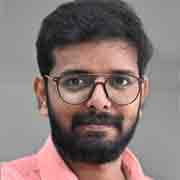When Stephen Hawking saw himself in Kerala’s Aranmula mirror: New book recounts rare meet

Mail This Article
Among the innumerable gifts received by legendary scientist Stephen Hawking from his admirers across the world, there is an ‘Aranmula mirror’, and a ‘kasavumundu’ -- two cultural symbols of Kerala. The beautiful alloy mirror, made by craftspeople of Aranmula, a small town in Pathanamthitta district, was gifted to the celebrated cosmologist by Dr Rajagopal Kamath, a science writer based in Kochi. Kamath met Hawking, whom he considers as his mentor, in August 2017 less than a year before the legend died.
Kamath narrates the details of the meeting of a lifetime in his latest book titled “The Cosmic Symphony”, recently published by TreeShade books, Noida.
Kamath recollects his rendezvous with Hawking in the first chapter titled ‘A memorable meeting’.
The meeting took place at Prof Hawking’s office in Cambridge, UK. It was indeed a dream come true moment for the Malayali researcher who has authored 30 books, both in English and Malayalam, on subjects such as astronomy, cosmology and new physics. Kamath was hugely influenced by Hawking’s masterpiece “A Brief History of Time”, first published way back in 1988.
In the book, Kamath says he had been in touch with Hawking’s office at the Department of Applied Mathematics and Theoretical Physics since 1997 through personal letters. Though he tried to meet the scientist several times the meeting did not take place due to the latter’s poor health.
When Kamath published a Malayalam book on the universe in late 1990s, he took the courage to approach Hawking for a short introduction to his work. Hawking, to his surprise, responded by sending him a biographical note with permission to use it. Kamath, however, did not include it in his book. Instead, he translated it to Malayalam and published for the benefit of science enthusiasts of Kerala.
When the real meet finally took place two decades after the first communication, Kamath was overwhelmed with emotions. Kamath was asked what he wanted to discuss with Hawking. Though he suggested the validity of the inflation theory, which described the early movements of the universe, as a topic to discuss, it was not entertained and the permission to meet Hawking was granted only after ensuring that the topic will not be discussed. There was some dispute among the scientific community over the subject then.

“On the left of the room Prof Hawking was reclining on his famous electronic wheelchair, in front of a table with a large monitor. My limbs trembled at seeing the familiar figure of the genius. It took a while for me to regain my normalcy. Here was the man worshipped by the scientific world. He was wearing woollen clothes and half shoes. They asked me to sit on a chair set right next to hawking. I was speechless. I heard Hawking’s famous voice saying ‘Hello, good morning’ through the speaker. His head tilted and I could read the smile,” Kamath writes.
Just behind Hawking’s chair, Kamath located a bookshelf with copies of Galileo’s “Dialogues Concerning two News Sciences” and Newton’s “Principia”. “Hawking smiled when he observed my curiosity as I looked keenly at the bookshelf. It was amazing to watch Hawking selecting words from the computer and construct sentences.”
Kamath says he spoke to Hawking about my his home state, Kerala with the help of his assistant Anthea Bain. “I detailed the landscape, climate, people, and the science of the place. On behalf of the science lovers of Kerala, I gifted him a ‘ponnada’, a golden-bordered shawl and a ‘kasavumundu’, a garment worn around the waist in Kerala, atraditional honour to dignitaries. His nurse placed the ‘ponnada’ on his lap. I also presented him Aranmula mirror, a masterpiece of craftsmanship from Aranmula, in south Kerala. Besides these, I gave him a copy of the Bhagawad Gita interpreted by Dr S Radhakrsihanan and a coffee table book, “Unseen Kerala”,” Kamath remembers in his book.
He says Hawking looked into the mirror eagerly and he took a picture of the moment. Kamath also presented to him a copy of the Samakalika Malayalam weekly which carried his latest article on methods of the universe. He was asked if he could translate it and he managed to detail the summary which included the latest advancements in cosmology and interpretations by Hawking. “He listened to it with much interest,” Kamath writes with pride.
“I had requested that his unpublished notes be made available to the new generation researchers. To my surprise, two weeks after my visit, his research thesis was available for free on Cambridge’s website,” Kamath remembers.
Towards the end of the chapter, he says Hawking’s assistant told him that he was one of the few privileged who could meet the great scientist during his last days.
Kamath says the purpose of his book “The Cosmic Symphony” is to illustrate the conceptions of the origin, evolution and probable future of the universe and to elucidate on great personalities like Hawking who arrived at their ideas of the workings of the system.


